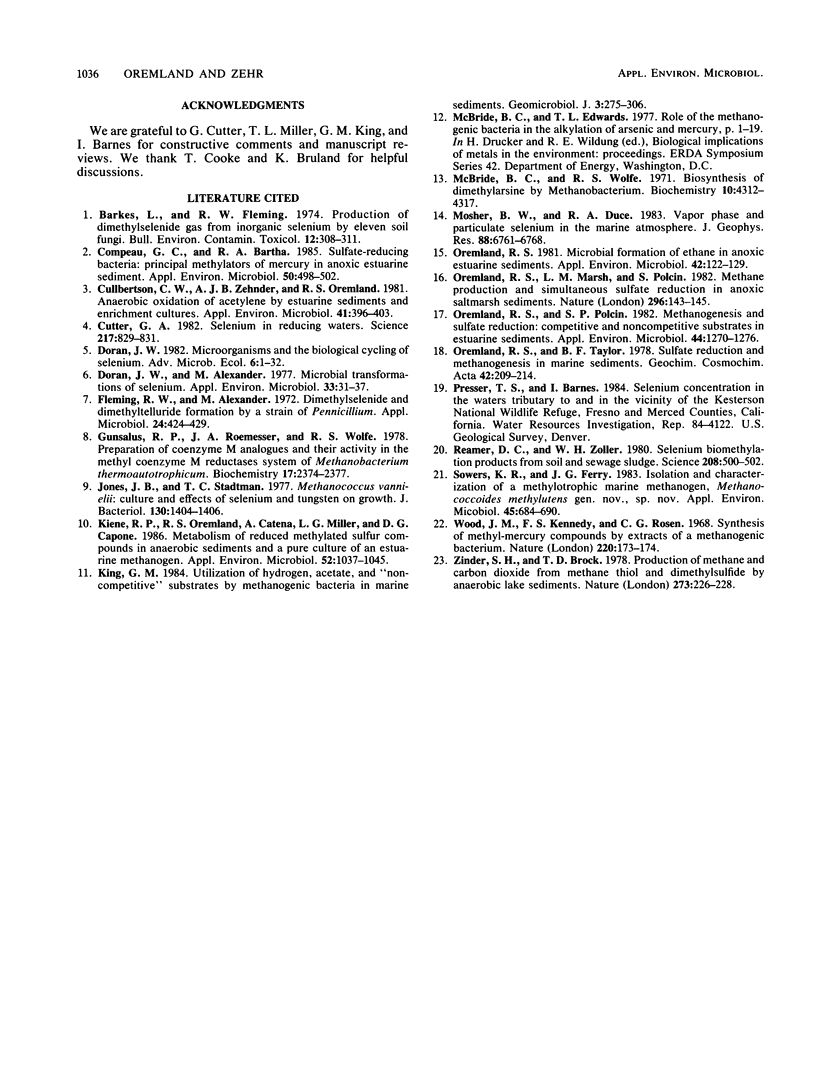Abstract
Anaerobic San Francisco Bay salt marsh sediments rapidly metabolized [14C]dimethylselenide (DMSe) to 14CH4 and 14CO2. Addition of selective inhibitors (2-bromoethanesulfonic acid or molybdate) to these sediments indicated that both methanogenic and sulfate-respiring bacteria could degrade DMSe to gaseous products. However, sediments taken from the selenium-contaminated Kesterson Wildlife Refuge produced only 14CO2 from [14C]DMSe, implying that methanogens were not important in the Kesterson samples. A pure culture of a dimethylsulfide (DMS)-grown methylotrophic methanogen converted [14C]DMSe to 14CH4 and 14CO2. However, the organism could not grow on DMSe. Addition of DMS to either sediments or the pure culture retarded the metabolism of DMSe. This effect appeared to be caused by competitive inhibition, thereby indicating a common enzyme system for DMS and DMSe metabolism. DMSe appears to be degraded as part of the DMS pool present in anoxic environments. These results suggest that methylotrophic methanogens may demethylate methylated forms of other metals and metalloids found in nature.
Full text
PDF





Selected References
These references are in PubMed. This may not be the complete list of references from this article.
- Barkes L., Fleming R. W. Production of dimethylselenide gas from inorganic selenium by eleven soil fungi. Bull Environ Contam Toxicol. 1974 Sep;12(3):308–311. doi: 10.1007/BF01709124. [DOI] [PubMed] [Google Scholar]
- Compeau G. C., Bartha R. Sulfate-reducing bacteria: principal methylators of mercury in anoxic estuarine sediment. Appl Environ Microbiol. 1985 Aug;50(2):498–502. doi: 10.1128/aem.50.2.498-502.1985. [DOI] [PMC free article] [PubMed] [Google Scholar]
- Culbertson C. W., Zehnder A. J., Oremland R. S. Anaerobic oxidation of acetylene by estuarine sediments and enrichment cultures. Appl Environ Microbiol. 1981 Feb;41(2):396–403. doi: 10.1128/aem.41.2.396-403.1981. [DOI] [PMC free article] [PubMed] [Google Scholar]
- Cutter G. A. Selenium in reducing waters. Science. 1982 Aug 27;217(4562):829–831. doi: 10.1126/science.217.4562.829. [DOI] [PubMed] [Google Scholar]
- Doran J. W., Alexander M. Microbial transformations of selenium. Appl Environ Microbiol. 1977 Jan;33(1):31–37. doi: 10.1128/aem.33.1.31-37.1977. [DOI] [PMC free article] [PubMed] [Google Scholar]
- Fleming R. W., Alexander M. Dimethylselenide and dimethyltelluride formation by a strain of Penicillium. Appl Microbiol. 1972 Sep;24(3):424–429. doi: 10.1128/am.24.3.424-429.1972. [DOI] [PMC free article] [PubMed] [Google Scholar]
- Gunsalus R. P., Romesser J. A., Wolfe R. S. Preparation of coenzyme M analogues and their activity in the methyl coenzyme M reductase system of Methanobacterium thermoautotrophicum. Biochemistry. 1978 Jun 13;17(12):2374–2377. doi: 10.1021/bi00605a019. [DOI] [PubMed] [Google Scholar]
- Jones J. B., Stadtman T. C. Methanococcus vannielii: culture and effects of selenium and tungsten on growth. J Bacteriol. 1977 Jun;130(3):1404–1406. doi: 10.1128/jb.130.3.1404-1406.1977. [DOI] [PMC free article] [PubMed] [Google Scholar]
- Kiene R. P., Oremland R. S., Catena A., Miller L. G., Capone D. G. Metabolism of reduced methylated sulfur compounds in anaerobic sediments and by a pure culture of an estuarine methanogen. Appl Environ Microbiol. 1986 Nov;52(5):1037–1045. doi: 10.1128/aem.52.5.1037-1045.1986. [DOI] [PMC free article] [PubMed] [Google Scholar]
- McBride B. C., Wolfe R. S. Biosynthesis of dimethylarsine by Methanobacterium. Biochemistry. 1971 Nov;10(23):4312–4317. doi: 10.1021/bi00799a024. [DOI] [PubMed] [Google Scholar]
- Oremland R. S. Microbial formation of ethane in anoxic estuarine sediments. Appl Environ Microbiol. 1981 Jul;42(1):122–129. doi: 10.1128/aem.42.1.122-129.1981. [DOI] [PMC free article] [PubMed] [Google Scholar]
- Oremland R. S., Polcin S. Methanogenesis and sulfate reduction: competitive and noncompetitive substrates in estuarine sediments. Appl Environ Microbiol. 1982 Dec;44(6):1270–1276. doi: 10.1128/aem.44.6.1270-1276.1982. [DOI] [PMC free article] [PubMed] [Google Scholar]
- Reamer D. C., Zoller W. H. Selenium biomethylation products from soil and sewage sludge. Science. 1980 May 2;208(4443):500–502. doi: 10.1126/science.208.4443.500. [DOI] [PubMed] [Google Scholar]
- Sowers K. R., Ferry J. G. Isolation and Characterization of a Methylotrophic Marine Methanogen, Methanococcoides methylutens gen. nov., sp. nov. Appl Environ Microbiol. 1983 Feb;45(2):684–690. doi: 10.1128/aem.45.2.684-690.1983. [DOI] [PMC free article] [PubMed] [Google Scholar]
- Wood J. M., Kennedy F. S., Rosen C. G. Synthesis of methyl-mercury compounds by extracts of a methanogenic bacterium. Nature. 1968 Oct 12;220(5163):173–174. doi: 10.1038/220173a0. [DOI] [PubMed] [Google Scholar]


